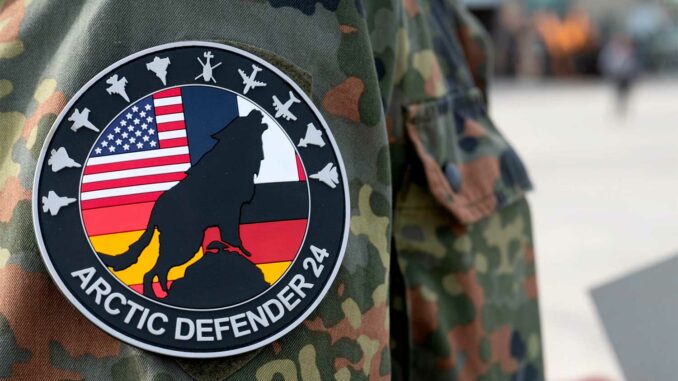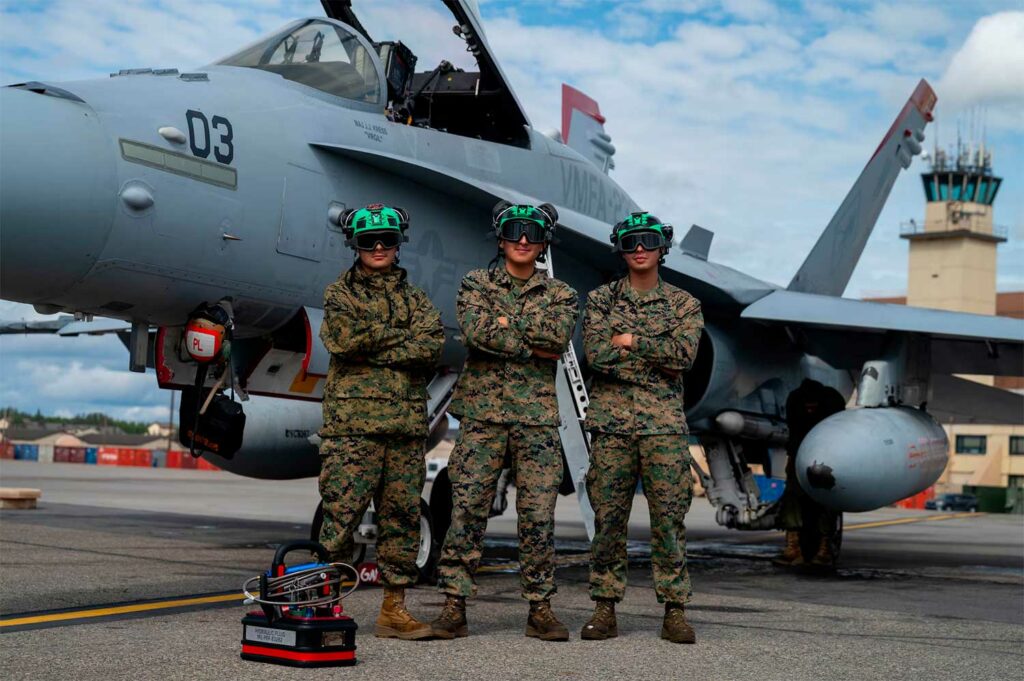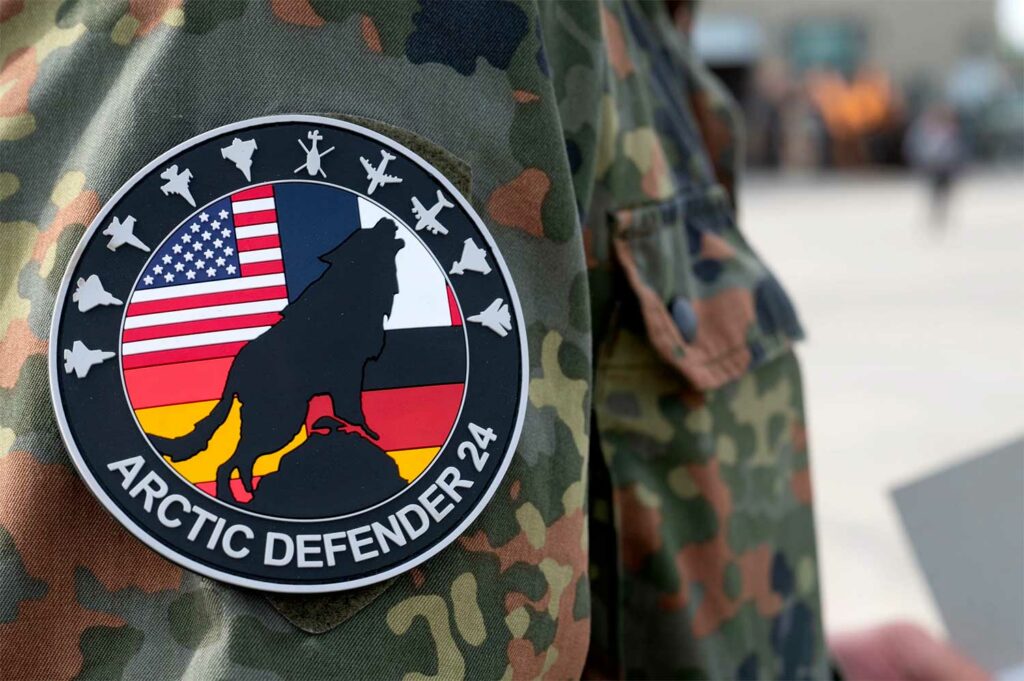
The Arctic Defender 2025 exercise in Alaska strengthens NATO interoperability for fighter aircraft in polar environments in extreme cold.
From July 8 to 17, 2025, the US Air Force renewed the Arctic Defender exercise in Alaska, aimed at verifying the interoperability of allied fighter aircraft in a demanding Arctic environment. Four nations are taking part: the United States, France, Germany, and Spain, with a joint deployment integrated into the Pacific Skies 25 cycle. This edition questions the operational capability to maintain air-to-air missions and ground strikes in a theater characterized by extreme temperatures, longer distances, and semi-permissive airspace.
Despite its international setting, Arctic Defender remains a high-intensity real-world test. Crews face major technical and human constraints, while state-of-the-art combat systems are put to the test in cold conditions and under logistical constraints. This article explores the technical, strategic, and operational lessons learned from the 2025 edition, comparing known data with that from the previous year.

A consolidated operational organization in the Far North
The 2025 edition took place from Eielson AFB and Joint Base Elmendorf-Richardson, where more than 600 personnel were stationed. Participants operated in the Joint Pacific Alaska Range Complex (JPARC), which covers approximately 170,000 km², nearly three times the size of Switzerland. This space offers the possibility of launching supersonic missions, very low-altitude flights, and simulated strikes over several hundred kilometers.
This year, the diversity of aircraft involved increased:
- USAF: F-35A, F-22 Raptor, F-16C
- France: Rafale B and Rafale C from Mont-de-Marsan and Saint-Dizier
- Germany: Eurofighter Typhoon and PA-200 Tornado on electronic warfare missions
- Spain: Eurofighter Typhoons from a permanent detachment
The flights took place in mixed French-German-American formations, with collective Arctic space defense scenarios detailing NATO Article 5 procedures, as evidenced by the command of Lt. Gen.
Extreme conditions remain a challenge:
- Temperatures ranging from –30 to –45°C, putting engine starts, hydraulic systems and lubricants to the test.
- Variable visibility, low clouds, blizzards, and constant cloud cover.
- Maintaining a pace of two to three missions per day, each lasting 30 to 90 minutes, requiring active and responsive logistics.
Technical objectives refined this year
In 2025, priority was given to:
- Interoperability of tactical systems: robust exchanges via Link-16, enabling the Rafale, Typhoon and F-35A to share radar data in real time, despite their different architectures.
- Harmonized target designation and fire control procedures, including simulated strikes and air defense suppression, respecting air-to-air and air-to-ground configurations.
- Integrated logistical support: sharing of parts and resources, especially air refueling via A330 MRTT (France) and A400M (Germany, France, Spain). This has enabled support between allied squadrons in less than four hours for tactical interventions.
Efforts focused on on-site maintenance in the polar environment. French teams deployed heated tents around the Rafale engines for pre-heating, reducing preparation times by 25% compared to 2024. The German Eurofighters tested specific filters for lubricant management in extreme cold.
The post-mission debriefing used 3D simulators to analyze flight paths, thermal stress, and tactics employed. This identified specific weaknesses in the Rafale’s passive IR detection modes in whiteout conditions. It highlighted the need to calibrate infrared sensors for these conditions.

Enhanced strategic and operational challenges
More than ever in July 2025, the Arctic Defender exercise takes on significant strategic importance. It signals the West’s determination to be armed and ready to face high-intensity conflict in the Arctic, an area where Russia is stepping up its presence.
France’s participation reinforces its global posture. The deployment of Rafale aircraft via A400M, and their integration into scenarios involving F-22 and F-35 pilots, demonstrates capacity to project forces over 7,000 km to a distant theater. The CDAOA has validated this projection as support for France’s posture in priority defense zones.
For Germany, the exercise provides an opportunity to test the transition from Tornado to Eurofighter/F-35 in electronic warfare and nuclear strike missions. Spain, with a smaller contribution, is using these training exercises to develop the skills of its young pilots.
In practice, Arctic Defender tests the continuous readiness of fighter aircraft in a sustainable framework with crew rotations and logistical relays. This poses a constant challenge for military leaders in supporting remote units in prolonged operations. Feedback shows that maintaining prolonged air-to-air combat capabilities with relative autonomy remains a sticking point, requiring ongoing funding.
Towards a sustainable polar readiness model
At the end of the 2025 edition, several lessons have been learned:
- Tactical interoperability is progressing but requires budgets for LINK systems, special fuels, and cold-weather infrastructure.
- Shared logistical support is proving effective: shared fuel tanks, spare parts, and air-to-air refueling.
- The endurance of pilots in extreme cold requires increased rotations and specific medical equipment.
- The suitability of radar and infrared sensors for polar environments requires dedicated calibration.
Strategically, Arctic Defender 2025 confirms that allies can deploy modern air forces in a theater considered sensitive. But repetition and budgeting remain essential. If the geopolitical context in the Arctic hardens, only a regular military presence will lend credibility to the allied commitment.
War Wings Daily is an independant magazine.